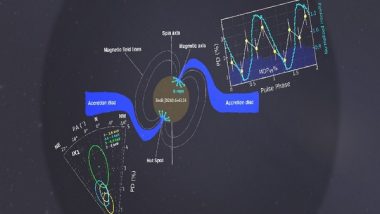Guwahati (Assam) [India], August 29 (ANI): In a collective effort, the Indian Institute of Technology Guwahati and Indian Space Research Organisation researchers have made a groundbreaking discovery that challenges the existing theories of emitted radiation from astronomical bodies.
The team of researchers was studying the first known Galactic Ultraluminous X-ray emitting pulsar, Swift J0243.6+6124, which shows that the polarisation of X-rays emitted by this pulsar is significantly lower than expected, challenging existing theories.
Ultraluminous X-ray sources (ULXs) are bright X-ray emitters from nearby galaxies that were once thought to be intermediate-mass black holes. However, some of them are believed to be pulsars because they emit regular pulses. Swift J0243.6+6124 is such a pulsar emitter, detected by NASA's Swift spacecraft during a strong X-ray outburst in 2017-2018 and identified as the first Galactic ULX pulsar due to its exceptional X-ray brightness.
The ISRO and IITG scientists focused on this source during its active period in 2023, using NASA's Imaging X-ray Polarimetry Explorer (IXPE) to detect the polarised X-ray emission for the first time. They also combined data from the Neutron Star Interior Composition ExploreR (NICER) and the Nuclear Spectroscopic Telescope Array (NuSTAR) missions.
Through their research, the scientists found that the polarisation of X-rays from Swift J0243.6+6124 was much lower than expected, around 3 per cent.
Speaking on the impact of these research findings, one of the co-authors of the paper, Dr Anuj Nandi, said, "The IXPE mission's unique capabilities made it possible to detect low polarisation in X-rays from the first known Galactic ULXPs. Notably, this low polarisation appears to vary with the emitted pulses."
Speaking about the research, Prof. Santabrata Das, Department of Physics, IIT Guwahati, said, "The discovery of lower polarisation in the X-rays from Swift J0243.6+6124 is important because it makes us rethink how these stars work. Neutron stars in binary systems have very strong magnetic fields that direct matter from a nearby star to its poles. This process affects the X-rays we see because the magnetic field influences how the X-rays behave. The polarisation of X-rays plays a big role in this. The unexpected low polarisation means our current understanding of these magnetic fields and X-rays needs to be updated."
This surprising result challenges current theories and raises new questions for further exploration. It also opens new opportunities for studying similar X-ray sources within our galaxy and beyond.
The details of this research have been published in The Astrophysical Journal Letters, co-authored by Dr Santabrata Das, Dr Anuj Nandi, and researchers Seshadri Majumder, Rwitika Chatterjee, and Kiran M Jayasurya. (ANI)
(This is an unedited and auto-generated story from Syndicated News feed, LatestLY Staff may not have modified or edited the content body)













 Quickly
Quickly
















